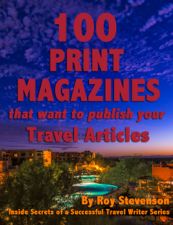- Home
- Getting Published
- Magazine Distribution Lists
How to Build Distribution Lists
to Sell More Travel Stories
By Roy Stevenson
Your query letter is a very important element of your marketing process. But the best query letter in the world won’t help you - unless you have a solid list of magazines to pitch your stories to.
I call these "distribution lists". You can also think of them as magazine lists or sales leads. For the purpose of this post, I'll simply refer to them as distribution lists.
Why are they important? These lists let you unlock the sales potential of your query letter and sell more stories.
Every serious writer needs these lists - these are your potential buyers. The more potential buyers on your list, the better. Right?
I
won’t try to sugar-coat it, but compiling your magazine lists is a
time-consuming process. Some of your longer lists will take days, even
weeks to compile.
But once you create your lists, you have them
forever. All you need to do is update them occasionally when an editor
changes, or when you hear about new magazines to add to your lists.
You might notice that I keep mentioning “lists” in the plural.
That’s because I recommend that you compile several distribution lists: one for each writing genre.
For example ...
I have lists about travel, running, fitness and exercise, beer & wine, military, and so on. Included on these lists are magazines, newspapers, and websites in that genre. Each genre is a separate list.
The idea behind a distribution list is to assemble a group of similar magazines that will be good targets for your proposed articles in a particular genre. You create a list once, then use it again and again each time you have a story idea for that genre.
Distribution lists are invaluable when doing simultaneous submissions, a technique that can increase your acceptance rate significantly.
Although distribution lists are time-consuming to create, it’s not a difficult process.
Here are the steps to creating your own magazine lists:
Look Everywhere for Publications
How and where do you find magazines to pitch your story ideas?
You look everywhere.
There are magazines published on almost every conceivable topic you can think of, and some topics you wouldn’t, so compiling your lists will not be a problem.
You’ll need to use several different sources.
First, visit newsstands. The magazine rack at your local bookstore is an excellent source of potential targets. Check the better-stocked magazine racks in your town.
In particular, visit specialty magazine stores, or newsagents. They tend to stock the more offbeat publications that are generally more “freelancer friendly” than the big glossies on the supermarket racks.
Next, use an Internet search.
The internet is a tremendous resource for tracking down magazines. It has no boundaries. It will even hunt down magazines from other countries for you. You’ll find more leads than you ever thought possible, and will soon have a sizable magazine distribution list.
Use magazine reference books, like Writer’s Market to add to your list. (Note: this is an affiliate link and if you click on it and make a purchase I will receive a small fee at no cost to you.)
Include magazines from other English-speaking countries. The most prominent ones in the U.K. are Writer’s Market, Writers’ and Artist’s Yearbook, and The Writer’s Handbook.
For the most thorough distribution list, I recommend you purchase at least two of these three. (I’ve listed details about these at the end of this article.)
Finally, subscribe to magazine databases. These vary in quality and number of magazines listed, but you’ll find some gems in them. Some of these websites are paid by subscription only.
Below you'll find a list of some magazine database websites. These are all targeted to the general freelance writing markets. If you write for a variety of genres, as I suggest that you do, then you’ll find some valuable resources to add to your lists.
Also, you can read this article with links to some of the best references for magazine leads.
I’ve subscribed to them all at one time or another. Spend some time surfing these websites and find two or three that seem like they’ll be a good fit for you. Then try them out and use them to help create your lists.
Some Online Magazine Databases for Freelance Writers
www.worldwidefreelance.com
www.writersdb.com
www.freelancewriting.com
www.freelancesuccess.com
www.writersmarket.com
www.writersweekly.com
www.writing-world.com
If you want to get published on travel websites, I've published a guide with a list of 125 quality websites.
Not all websites are quality websites. Many travel websites don't accept articles for publication. Some website owners prefer to write their own stories.
Others are content mills. You really want to stay away from these. They're bad for your reputation.
I thoroughly researched my list of 125 travel websites, and can say that you will be proud to be published on any of these fifty. You can learn more here.
Create a Spreadsheet or Table for Each List
As you gather your information from these sources, keep track of them on a list. You can use a spreadsheet or a simple table in your word processing program.
Here’s the basic table format that I use:

Keep Each Genre in a Separate List
Even though you might sell some of your articles to more than one genre, it’s best to keep them separate. That way, when you have a story idea that applies to a specific genre, you don’t need to sort through hundreds of irrelevant items.
Everything relevant to that genre is on a single list.
(Note: If you're savvy with spreadsheets or databases, you will only need a single list with genre codes for each publication. Then you can sort by genre as needed.)
Add More Notes Over Time
I also keep track of information that I’ve gathered from correspondence with editors.
One example:
When I find out a magazine doesn’t pay it’s writers, I’ll make a note of it on this list with a note to myself “doesn’t pay - do not pitch”. I don’t delete it from my list simply because I don’t want to accidentally spend time researching and pitching the same publication again.
You might also make notes about whether they prefer that you submit photos with your articles, and whether or not they pay for photos. The “Notes” section can get fairly lengthy but, once again, once the information is entered, it’s there for the future.
The point is, make the Notes section helpful to you when using your list to find target publications.
Using Your Distribution Lists
The beauty of building distribution lists is that you now have a resource for selling your articles. When you have a story idea, you can review your list and think, “who might be interested in this story?”
Then all you have to do is send out your query letter to the people you’ve selected from your already prepared list.
It’s a lot of work up front to build your lists. But once you have your magazine lists, selling your articles becomes a faster and easier process. It will, ultimately, allow you to earn more with your travel writing.
As promised earlier in the article, here are the details for the U.K. reference books that you can use to help build your distribution lists.
U.K. Magazine Reference Books
Writer’s Market UK
David & Charles Publishers
The U.K. equivalent of the U.S. Writer’s Market. Lists magazines and newspapers in the U.K. and Ireland. An essential reference for freelancers wanting to be published in the U.K.
Writers’ & Artists’ Yearbook
A & C Black Publishers
Another U.K. reference that lists regional and national magazines and newspapers in the U.K. and Ireland. Their 2020 Yearbook is available now at this link:
www.writersandartists.co.uk
If you want to get published on a travel website, I've published a guide with a list of 125 quality websites. This list includes more than 50 paying websites and lots of advice about getting published online.
Not all websites out there are quality websites. Many travel websites don't accept articles for publication. Some website owners prefer to write their own stories. Others are content mills - you really want to stay away from these. They're bad for your reputation.
I thoroughly researched this list of 125 travel websites, and can say that you will be proud to be published on any of these. You can learn more here.
Related articles that will interest you:
Query Letter Mistakes and How to Fix Them
Simultaneous Submissions: Sell More and Do It Faster
Getting Published: The Many Ways to Sell Your Travel Stories

Roy Stevenson is a professional travel writer and the author of www.PitchTravelWrite.com. Over the past ten years, he’s had more than 1000 articles published in 200 magazines, trade and specialty journals, in-flights, on-boards, blogs and websites and has traveled on assignment around the U.S. and to dozens of international destinations.
IF YOU ENJOYED THIS POST, GET UPDATES. IT'S FREE.














